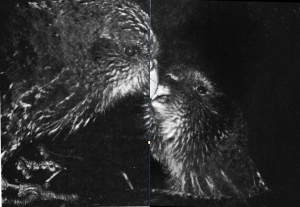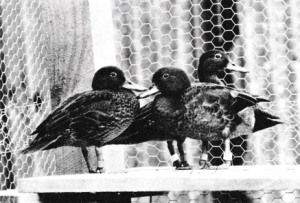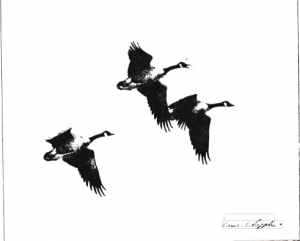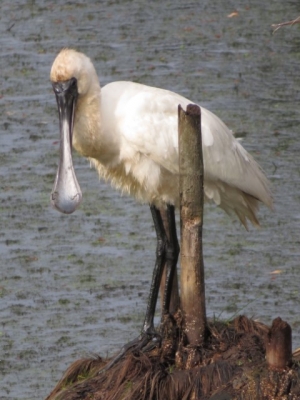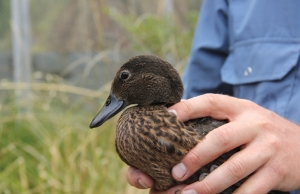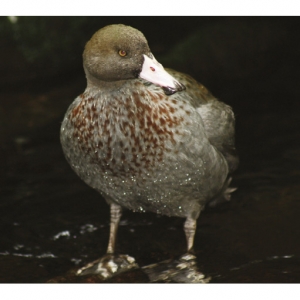Displaying items by tag: Breeding
Report on Operation Branta (Canada Geese)
Mr F.N. Hayes re—stated DU's objective to permanently establish the Canada goose in the North _ Island, which is being achieved by transferring geese from the South Island and releasing them in a pinioned state on to suitable dams and lagoons. He outlined the history of the project, since 1977, concerning geese supplied from the South Island and also those bred by North Island DU members and zoological societies and supplied to the project. The majority of geese have been distributed to farmers in the Wairarapa in groups of 6—8 birds per lagoon. The Wellington Acclimatisation Society Senior Field Officer has been largely responsible for distribution of geese in the Wairarapa district and DU's appreciation was extended to Mr Ian Buchanan and to the Society for its co-Operation. Thanks were also expressed to the North Canterbury Acclimatisation Society. Mr P.M. McLeod received special thanks for his part in arranging shipments of geese to the North Island since 1977 - also Mr L. Piper of the North Canterbury Society's game farm for his outstanding assistance.
The establishment of the species in the North Island was progressing well and apart from the good breeding results in the Wairarapa, very healthy populations were being established in the Bay of Plenty where approximately 200 birds exist, and in Hawkes Bay where there is about the same number.
These populations have grown from wildlife Service releases in the l960/70s.
Concern was expressed at recent moves in the South Island to return the Canada goose to a non-protected status there. Canada geese are partially protected at present and DU considered a change in this status (achieved only last year) would ultimately lead to the species' annihilation in the South Island. Comments were made from the chair and the floor that the Canada goose in New Zealand has been and possibly still is one of the most maligned and abused forms of wildlife. A decision had to be made whether to manage the goose constructively or destructively while, at the same time, acknowledging all viewpoints commented Mr Hayes.
These remarks were followed by comments from members on the need to keep in perspective the whole question of Canada Geese in New Zealand and the President confirmed that Ducks Unlimited would be closely monitoring the situation.
History made on Stewart Island
For the first time in living memory, men watched while the Kakapo population increased by two. The wildlife team on the island described the find as ‘mind boggling‘.
The N.Z. Wildlife Service team have good reason to pat themselves on the back. Since 1977. when they discovered a community of thirty of the rare birds on Stewart Island. they‘ve been working hard to preserve the species.
The discovery of the two chicks was an indication of how important the team‘s work in eradicating pests. tagging and studying the birds has been.
The Kakapo needs your help too.
The wildlife team. whose good work became so evident recently. need somewhere to live while they study and protect the Kakapo. The World Wildlife Fund has set the Project Kakapo target at $25,000 to build and equip a hut with basic living and research facilities.
Because all materials must be ?own into the remote and rugged regions of Stewart Island by helicopter. the cost of construction will be high. But it’s the ?rst step on the road to survival for this unique and delightful New Zealand bird.
Build the hut or see the Kakapo fade into myth — the choice is yours.
Support Project Kakapo.
Less than a hundred Kakapo remain — a bare few in Fiordland. and the small colony in almost inaccess— ible parts of Stewart Island.
The Kakapo’s survival is dependent on your support.
The World Wildlife Fund has committed $25.00( to supporting the Kakapo, it needs your help to raist the money.
Without your help the Kakapo will die.
How much do you know about the Kakapo?
Probably next to nothing, because little is known even by trained naturalists and researchers, about it: life cycle, its habits, its rituals. its young — even its life span.
The Kakapo is as big as a goose, booms like 2 bittern, climbs trees, digs holes and looks very like at owl. The bird remains one of nature’s riddles. Flight less, nocturnal, the Kakapo is the world’s biggest ant strangest parrot, it has a separate sub—species classifica tion all of its own.
With moss green body feathers and bronze wings, the Kakapo waddles as it walks. It looks for all the world like a plump and stumpy Charlie Chaplin as it beats feeding tracks across dense scrubland in southern Stewart Island.
Tearing moss and grass roots from the boggy, peaty ground, its food is held in long claws and nibbled with a powerfully hooked beak.
But for all its apparent armament, the Kakapo is a placid, docile creature, certainly no match for the killers of the bush,
Wild cats and dogs maintain a reign ofterror. Mauled skeletons of members of Stewart Island’s
Kakapo community are sad relics of the havoc caused by predators imported by the early Pakeha settlers.
Dogs hunt, kill and eat Kakapo. But the biggest threat comes from the wild cats, whose agile speed makes the slow-moving Kakapo easy prey.
The New Zealand Wildlife Service team will send their specialist in wild cat eradication, to Stewart Island — but like other members of the team, he needs shelter. The donation you make will house this man and others like him, who may need to spend up to ten years studying, learning and keeping the last Kakapo colony in New Zealand alive. The current research team is living under canvas in conditions of extreme hardship in the same remote corner of the island where the Kakapo have been herded.
To keep the research team the Project Kakapo hut mustd be built. Otherwise the Kakapo cannot be protecte .
Where do I send my donation?
Please help save the Kakapo by sending a cheque, postal note or money order to:
Project Kakapo
World Wildlife Fund
P.O. Box 12-200
WELLINGTON NORTH
A receipt will be posted to you — and all deductions of $2 or over are tax deductible within the prescribed limits. The money you give to Project Kakapo will be used only for Project Kakapo.
The Kakapo will live —- with your help — if given now.
Report on Operation Pateke (Brown Teal)
Mr F.N. Hayes outlined the year's highlights - among them the first official recording of captive reared Brown Teal in the wild on the mainland; and the outstanding figure of 101 birds reared to maturity by DU members — expressing thanks to all concerned and particularly the N.Z. Wildlife Service and Messrs J. Gill, 5- Bronger, J. Campbell, J. Glover and W. Clinton—Baker. of the 101 birds reared, 64 were released on Matakana Island, 22 were retained for flock mating and 15 kept fcrrelease in August at Puke Puke Lagoon. Including the 25 birds reared by the N.z. Wildlife Service, Brown Teal reared in New Zealand last breeding season numbered approximately ten per cent of the estimated world population.
In the United Kingdom the Wildfowl Trust has reared 30 birds in the two seasons since Ducks Unlimited sent two females for its collection. It would be some time before the target of 50 breeding pair would be reached but the group was confident this figure would be achieved. The objective for the coming year was 40 pair held by 20 Ducks Unlimited members.
Mr Hayes advised that the Wildlife Service had paid Ducks Unlimited $ 5 for each bird released to the wild - this was passed to breeder members, together with a further $ 5 as a token reimbursement of cost for rearing to maturity. Favourable comments had been received concerning the Brown Teal booklet produced following the Brown Teal seminar in 1980 and thanks expressed to Mrs C.L. Pirani for assistance with production and Dr M. Williams of the Wildlife Service for technical assistance.
Mr Hayes concluded by stating Ducks Unlimited was confident the current season's record would be exceeded in the coming year and that the group was searching for further release sites. He answered questions concerning publicity on television and in scientific journals; population levels; fundraising for the project and stated that the aim was to maintain a stable population level for Brown Teal in the years ahead.
Report
Brown Teal released at Puke Puke Lagoon:
On 9 August 1981 DU released 12 Brown Teal at Puke Puke Lagoon, Foxton — 8 females and 4 males. This is the first time DU has released birds at this time of year and the resident Wildlife Service technician at Puke Puke Lagoon will be keeping a close watch to see how the birds adapt. All 12 birds were those reared towards the end of last breeding season, too late for release during last summer. Thanks to Mr J. Glover for holding most of the birds during the winter. The latest release brings to 76 the number of Brown Teal released during 1981.
Brown Teal at the Wildfowl Trust, Slimbridge: The Wildfowl Trust reports an excellent 1981 breeding season. Slimbridge reared 25 and the two other centres, Martin Mere and Peakirk, have also done well but no figures are available as yet. Overall this indicates that over 50 Brown Teal have been reared in the United Kingdom since DU sent two females in 1979. The Trust now plans to distribute pairs to their other two centres, to leading aviculturists in the United Kingdom, Europe and possibly the United States. The Wildfowl Trust and Ducks Unlimited feel that this is a very important safety aspect should anything unforeseen occur with the species in New Zealand.
1981/82 breeding season: Several breeders have reported eggs being laid during August and hopes are high that DU will break last season's record of 101 Brown Teal reared. This season we will have 40 pair of Brown Teal held by 18, possibly 20, members — well on the way to the 50 breeding pair target. The Wildlife Service will have 10 pairs for the coming season.
Report on Operation Gretel (Grey Teal)
BARTON'S LAGOON, Wairarapa
Neil Hayes reports three clutches "on the go" following the first maintenance/straw replacement visit on 2 August 1981.
He comments that at least 80 Grey Teal were using the lagoon.
Waikato
Dudley Bell has summarised the 1981 breeding season (to 6 September) as follows:
"Initial inspections were made on 1 August. One new area was inspected but found to be unsuitable. Three areas were inspected, totalling 66 boxes - 31 at Lake Are Are; 10 at Tangirau and 25 at the Mountley site.
Lake Are Area produced no results for this its first season. New hay shavings were placed in a number of the boxes and the area left to the ducks.
Tangirau showed a one hundred per cent improvement on last year with 2 boxes of the 10 being utilised. Both boxes had 8 eggs being incubated tightly by the female.
Mountley showed its usual excellent results with 14 boxes being utilised and 119 eggs laid. Eleven eggs were already lost to flooding in the lower boxes. A promising start.
The next inspection was at the Mountley site only, on 6 September 1981. Here, this time, was outstanding success with 23 of the 25 boxes being used. 145 eggs were laid. Bl of the previous inspection eggs had hatched giving 68% success. There were 6 eggs lost for no apparent reason — being cold and disarranged in the nest. This left 32 eggs unhatched or infertile. Some may not have been removed on the 6 September inspection as new nests were under way. In some new nests it appeared that old infertile eggs remained — a crowding problem I believe. One nest had 6 newly hatched young and four ready to hatch eggs.
Two broods of young Grey Teal were seen on the area in the open water. One of the broods was young and comprised 7 ducklings and the other almost fledged and comprising 6."
Report on Project Gretel
Mr D.G. Bell reported another successful year for Grey Teal breeding — for the birds and in specific cases for the DU nest boxes. Highlighted areas were Pokeno, Ngaruawahia and Martinborough which enjoyed maximum performance from nest boxes; the "hard—luck" story of the year was at Dunedin where above normal water levels left boxes submerged with disastrous results.
Pokeno boxes achieved excellent results with 1,185 eggs laid, 621 hatched from 801 incubated — the average clutch size was 11 eggs. Mr Ian McFadden, Wildlife Service Officer on the site at Pokeno has prepared a comprehensive report on this two year study from which much valuable information will be obtained. At the nestbox site in Ngaruawahia 18 of the 25 boxes were utilised and the area was "alive" with Grey Teal, 130 eggs being incubated from 156‘laid. This lagoon is about a quarter hectare in size and adjacent willow swamp is no more than one hectare which provides a totally utilised situation for the Grey Teal.
Barton's Lagoon in the Wairarapa recorded an "amazing performance" for a small area - 300 eggs laid in 18 of the 30 nest boxes. Most recent observations have been of 50 Grey Teal inhabiting the area compared with 2 or 3 pairs seen before box establishment. During the year 131 Grey Tal nest boxes were erected in many parts of the North and South Island. A grant of $ 500 was received from the Ministry of Recreation and Sport and enabled box work to be accelerated.
Special thanks were given to the N.Z. Wildlife Service for valuable participation, especially in the monitoring the Pokeno production, and to members and friends who took part in the erection and monitoring of nest boxes around the country. Owners and controllers of wetlands also received a special vote of thanks as without their co—operation the project would not exist.
Mr Bell answered questions concerning the accidental shooting of Grey Teal during the season and comments were received from the floor that this would continue to be a problem in future because of confusion over identification.
Mr Bell concluded his remarks with the comment that it was most encouraging to see acclimatisation societies, with their large voluntary and enthusiastic workforce supporting the DU project; and that Ducks Unlimited would like to see an even greater awareness by waterfowl enthusiasts in New Zealand toward Operation Gretel and its objective to improve Grey Teal numbers.
Grey Teal to Nga Manu Trust
The birds are to be released at the Nga Manu sanctuary near Waikanae which has a park-like setting with bush walks,
swamps and ponds.
DU Exports NZ Shoveler
August, sent by Ducks Unlimited.
Our cover shows DU member Julian Hayes about to place the first of the shoveler into the export crate.
Spoonbills New Zealand
Reports of sightings in the past decade point to a growing population of royal spoonbills in New Zealand. Te Papa bird expert Dr Colin Miskelly backs this up, saying there are signs that the spoonbill, kotuku ngutupapa, is "increasing at a rapid rate".
The first spoonbill sighting was recorded in New Zealand at Castlepoint in 1861.
Sightings increased through the 1900s, with breeding first recorded next to the white heron colony at Okarito, south Westland, in 1949.
Since then it has successfully colonised New Zealand from Australia and is now widespread, breeding on both main islands, and dispersing to coastal sites across the country after the breeding season.
In 1977 the New Zealand population was estimated at 52 birds. The most up-to-date estimate (in 2012) was 2,360 birds, though the population is now thought to have exceeded 3,000.
A colony and nest count during the 2013-14 breeding season found 19 colonies with at least 614 nests.
It breeds in the exposed canopy of tall kahikatea trees, on the ground near estuaries, rivers and harbours, in reeds, in low shrubs, and on steep rocky headlands, tending to breed near white heron and shag colonies.
It prefers freshwater to saltwater but can inhabit both. Royal spoonbill is one of six spoonbill species worldwide but the only one that breeds in New Zealand.
Source: Szabo, M.J. 2013 [updated 2017]. Royal spoonbill. In Miskelly, C.M. (ed.) New Zealand Birds Online. www.nzbirdsonline.org.nz.
Pateke numbers improving
The brown teal (pāteke) is one of three endemic teal to New Zealand and the only one to fly. Both the Auckland Island and Campbell Island teal are flightless.
Mainly nocturnal and half the size of a mallard, this shy, omnivorous duck spends time on land foraging for invertebrates, seeds, fruit, grass, and foliage. With dark brown plumage, the males are particularly distinctive from their female counterparts during breeding time in late winter.
The slightly larger males in breeding plumage obtain a green iridescence on their heads, a dark chestnut breast plus occasionally a thin white neck ring too.
Like many of our native birds, this small-necked dabbling duck has dramatically suffered from mammalian predators, loss of habitat and hunting, resulting in a plummeting population to only 700 birds in the wild by the 1990s.
Brown teal were once widespread, but thanks to brown teal species co-ordinator Kevin Evans and the Department Of Conservation brown teal recovery group, in the past 15 years, this population decline has not only been halted, but reversed, building up to about 2500 birds in the wild today.
Numbers are slowly recovering and there are several contributors to this success:
Captive breeding facilities across New Zealand that produce birds for release.
The Isaac Conservation and Wildlife Trust (ICWT), which provides facilities for flock mating for other institutions, and breeding plus pre-release conditioning and processing (banding, transmitter attachment, worming, disease screening, etc). Every captive raised bird goes to ICWT as its aviaries have stream-fed waterways for foraging, plus special feeders where the brown teal learn to obtain food. These feeders are also located at release sites.
DOC together with community groups undertake intensive predator control at release sites.
There are generally four releases of brown teal a year and the latest release of 32 birds was in August in the Abel Tasman National Park in an area managed by Janszoon.
Preparing the birds for release is an exhausting but rewarding task for all those involved at ICWT (assisted by Kevin Evans).
All release sites are vigorously assessed to ensure pāteke are released into areas with adequate protection and habitat to support self-sustaining populations.
[Ducks Unlimited was instrumental in early conservation efforts from 1975 with its ‘Operation Pateke’, New Zealand’s first large-scale co-ordinated brown teal breeding programme. – Editor]
Whio exceed target in Fiordland
The Department of Conservation has high hopes for the upcoming whio breeding season in Fiordland. About 64 breeding whio were found earlier this year in a survey of a security site for the blue ducks.
Senior ranger Andrew (Max) Smart says this means the northern Fiordland site is the first in the South Island to exceed the target of 50 breeding pairs.
“Security sites are the highest priority whio conservation areas in the country; there are four in the North Island and four in the South Island.
"The target of 50 breeding pairs is set for each security site through the Whio Recovery Plan. A couple of sites on the North Island have reached this target, but we’re the first confirmed site on the South Island to do so.”
Whio have come a long way since 1999/2000 when only three pairs were found in this security site, Max says. “This year’s number is only a minimum and there could be up to another nine pairs.
“Extended trapping efforts and landscape scale predator control have enabled the whio here, and at key sites around New Zealand, to make a strong comeback.”
Whio are monitored using walk-through river surveys using specially trained conservation dogs. Two surveys a year are planned for each river.
The first survey, in November and December, counts the number of ducklings, as well the number of individual birds and pairs seen. The second survey, generally in January and February, counts the number of fledglings.
Exceeding this target is great news for whio, but according to Max, there is still a lot of work to do to secure a future for this species.
“We are only doing work over a relatively small area and this is where we are making a difference. Predator control has to be kept up and expanded for whio to have a chance to increase in number and spread over their natural range.”
Captive breeding keeps up Whio numbers
Peter Russell keeps a watchful eye on Whio to make sure the numbers are kept up and they return as much as possible, to the areas where they started life.
Breeding Results
The past year has been the best to date with 26 ducklings reared and released back into the wild. This was achieved by three pairs, the Auckland pair produced 11, the pair at Peacock Springs having 10 and the Orana pair five. These pairs had all been flock mated. Both the Auckland and Peacock pairs did double clutch which really helps with numbers produced.
Three pairs at Hamilton, Palmerston North and Staglands that I was hoping would produce, did nothing. I hope they do better in the coming season.
Flock Mating
This season we have flock mated four more pairs that gives pairs to Otorohanga, Mt Bruce, Queenstown and another pair at Peacock. I was a bit disappointed with Mt Bruce who took so long in sending male birds to Peacock that the female in the new pair at Peacock laid a clutch of eggs without a male.
It was also disappointing that no wild clutches came in last season to keep on making up more pairs for captive population.
Releases
The first release of 10 was at Egmont National Park on the January 29 with Andrew Glaser of DoC coming over and taking staff through putting transponders in and a video team taking footage of this and the release. We had a group of school children who attended and Andy was in his glory.
The second release was on the Manganui-a-te-ao and it was good to see Alison Beath also of DoC come down to put the transponders in. We released a total of eight birds with two older birds which came from there as juveniles and have only bred once and hadn’t done anything for the last three years. It was a great day. Lots of school children.
The third release was on the Tongariro which also went really well with lots of people and Genesis staff involved. Six birds were released. The last release was back at Egmont on a Saturday so their volunteers could attend as most of them work during the week. There were four birds plus a duckling I had hand reared and then sent to Peacock Springs so it would be brought up with other birds.
It has been so much better now with Air New Zealand sponsorship for moving ducks about and saving costs on breeders and Peacock Springs when sending for release. It is a bit more work for me but it goes with the job.
Quality
Duckling quality is very good and I am sure that the matting’s we are doing with eggs that are coming in is paying off with a very good bird for release.
Deaths for the year
There were seven deaths during the year. Two were neonatal and one a 20-year-old male and another 19-year-old male. We also lost 15 males including one eight-year-old. These males were not in the breeding programme.
The breeding male from Auckland Zoo died after a very good first season. The female is now at Mt Bruce and has been flock mated with the surplus wild males.
Pairs still needed at: 1. Nga Manu, 2. Mt Bruce, 3. Peacock Springs, 4. Kowhai Aviary, 5. Willowbank, 6. Auckland Zoo, and 7. Ron Munro. We need to bring in more clutches this coming season. Releases for next year Egmont wants to carry on releasing next season though we still need to look for new sites. Also returning birds to areas were the clutches of eggs are from.

